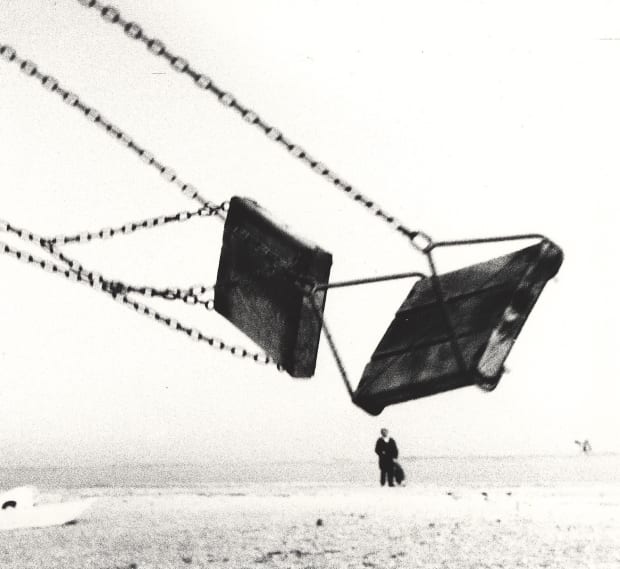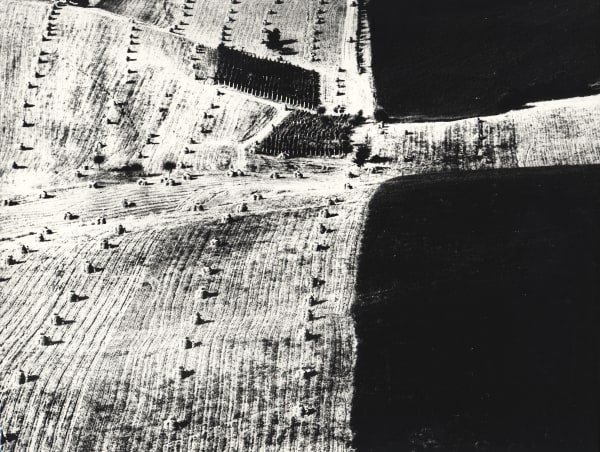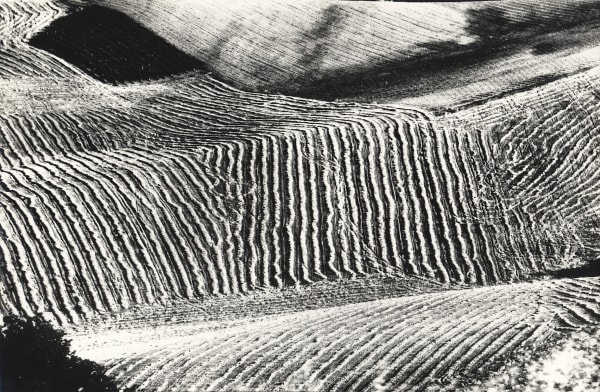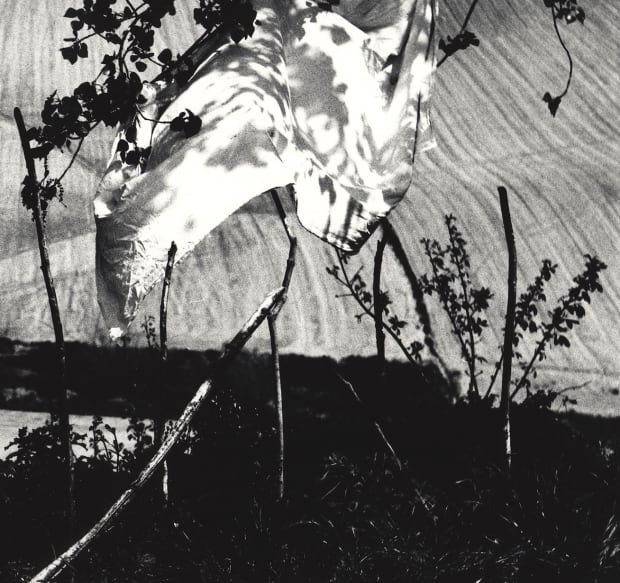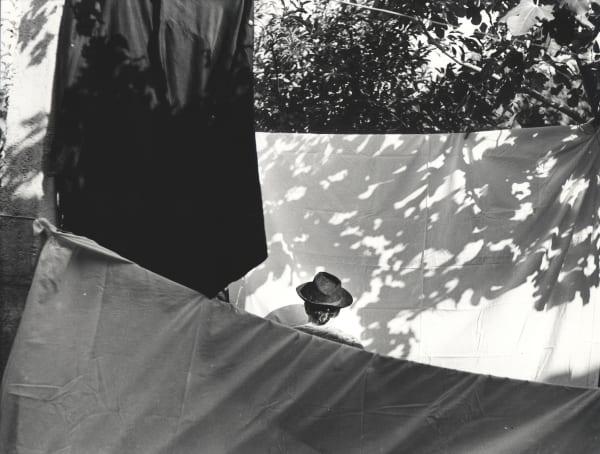-
Mario Giacomelli
REVISITED -
Giacomelli's practice is one of meditation on universal themes of time, memory and human existence.
Mario Giacomelli is widely considered one of Italy's foremost photographers, whose work spoke to a post-war modernist visual language and whose œvure went beyond the popular photojournalism style photography of the time. Giacomelli preferred a grainy texture, geometric compositions and high contrast to his work, creating compositions that are both dreamlike and immediate as he explores the possibilities of abstraction within the medium of photography. The strong lines, fields of stark monochrome and abstracted subject matter speaks to work being created on paper and canvas by other artists in Europe and the United States during this time.
While Giacomelli has been called a humanist photographer working in a photojournalistic style, it is possible that Giacomelli was a pure artist using his camera and lens to create painterly compositions that were ultimately modernist in style. For Giacomelli, the camera was not just a tool for recording reality, but it was a means of personal expression, presenting everyday life and ordinary people as thinking and feeling subjects. When turning his lens on the land and inanimate objects, Giacomelli was able convey the visual poetry he witnessed in his surroundings through his abstracted images. The artist produced photographic works that were defined by the raw expressiveness of the images, which echoed both the aesthetics and themes postwar Neorealist film, Existentialist literature and theories of Subjective photography.
Subjective photography was an international movement founded by Otto Steinert in the early 1950's which championed photography that explored the human condition and inner psyche rather than simply reflecting the reality of the outside world. While Giacomelli lived in worked in the same Marche region of Italy his entire life, he was involved in camera clubs that exchanged these progressive ideas and thus applied them to his own practice. Mario Giacomelli spent years revisiting familiar themes of landscape, seascape, and the people of the Marche region, reworking compositions and ideas for decades. Giacomelli's practice is one of meditation on universal themes of time, memory and human existence.
The artist rarely applied titles and specific dates to individual images, instead titling entire bodies of work from his own poetry and assigning a range of dates to the works, in this way Giacomelli created bodies of work that are both deeply personal, immediate to his surroundings and indivisible from each other, but universal in the emotion and energy they convey to the view. Giacomelli adeptly combined a humanist and expressive approach to his images, understanding that embracing the grainy texture, capturing movement and creating his compositions in high contrast, gave the artist the ability to heighten the emotive power of the final images. It is important to note, the images are timeless in their ability to be interpreted just as poignantly by a contemporary eye as they would have been when first viewed during the artist's lifetime.
Black Box Projects will offer vintage prints alongside life-time prints, available exclusively through the gallery. Many of the works included in the virtual exhibition at Black Box Projects will also be on exhibition at the Getty Museum in California in a major survey of over 110 works by the artist from the collection of Daniel Greenberg and Susan Steinhauser, from 29 June 2021. Abstracted works by Mario Giacomelli will be on exhibition at the Maxxi Museum in Rome as part of the Giacomelli and Burri exhibition, opening October 2021.
Mario Giacomelli: Revisited is presented in collaboration with art advisors Daniela Duppen (@theblondeartdealer), Anna McHugh (@annamch.art) and the Mario Giacomelli Archive.
-

-
"For me each photo represents a moment, like breathing. Who can say the breath before is more important than the one after? They are continuous and follow each other until everything stops. How many times did we breathe tonight? Could you say one breath is more beautiful than the rest? But their sum makes up an existence."
- Mario Giacomelli, 1987
-
VISUAL POETRY
Mario Giacomelli's œuvre is defined by mark making within his photographic compositions. The artist has a keen eye for pulling out definitive marks, lines and patterns from his images - no matter the subject. Whether it be a furrow scarred into farmland, laundry flung onto grass, whisps of hair blown in the wind, portraits found in inanimate objects, swings at a funfair or seaweed washed ashore, Giacomelli infuses his compositions with deliberate lines, mark making, and rhythms suggestive of poetry. His series interweaves images in a similar way that phrases are rhymed in a poem. The whisp of hair blowing in the wind reflect the seaweed washed ashore on the beach, the chains of a funfair swing reflect the purpose made marks in the farmed landscape, the interlinked possibilities are endless as these works relate to one another over decades of seperation in time and place. The images of Poesie in cerca d'autore (Poems in search of an author) are nostalgic, relating memory to place, and interweaving the compositions from this series to other bodies of work by the artist. In this way, the images presented to us by Mario Giacomelli are not unlike a personal diary or fond reminiscing of lifes moments, capturing fleeting moments of beauty and meloncholy, their sum defining an existance.
-

-
A mark, a memory, and recording the passage of time
Giacomelli's landscapesContinuing his study and meditation of time, memory and existence, Mario Giacomelli turned time and time again to the subject of the landscape of the Marche region where he lived. Instead of creating landscapes with a discernible horizon and scale, the artist created distinctly abstracted compositions which left the viewer unable to grasp scale or perspective. The images transform to be not just about the landscape, but rather a study of the marks made into the land after centuries of farming, and the rise of modern industrialized farming as well as a comment on the passage of time and memory. Giacomelli frequently compared the Italian landscape to the female body, both fertile and able to sustain life, but suseptible to the physical scars and marks which happen with the passage of time. Shooting on expired film which results in an enhanced grainy texture and high contrast to the final image, Giacomelli creates a compelling metaphor both with how he is working to create his works and his final images. Using expired film to capture land that has been scared and forever changed due to human intervention, the artist uses both his methods of creation and compositions to point to the dangers of modern progress on the natural environment. The decades-long study of the man-made marks and scars on the landscape can be compared to the passage of time, aging of the body, and even our own transience and mortality.
In his early landscapes, Giacomelli would often intervene into the composition by making scratches and marks on the negative as a way of creating the exact composition and heighten the dramatic expression he sought for the final image. In later works Giacomelli would collaborate with farmers and instruct the marks to be made into the earth - or even drive the tractor himself making distinctive marks in his wake - at scale in order to create his desired final composition of highly graphic abstraction. Interestingly this new way of working for Giacomelli - intervening into the land and creating a new landscape - coincides with the rise of land art in the 1960s - 1970s. Giacomelli speaks of his intervention in nature, often transcribing a poem on the back of his prints: "conscience of nature, the work of men, my intervention." In english "intervention" means "to interrupt", but in the Italian language an intervention is defined as a meeting. These works saw Mario Giacomelli meeting the land and making his own bold and graphic marks, not to be disruptive but rather to leave his own legacy on the face of nature, a landscape that both formed his identity and informed over 50 years of image-making.
Perhaps the most lasting and iconic series created by the artist, Giacomelli's landscapes are fundamentally modern in their visual language, often resembling etchings in their high-contrast style and resonating with the expressionist art movement with his embrace of expressive and emotive mark-making. In his near five-decade study of his surrounding landscape, Giacomelli created a body of work that sits equally within the cannon of modern art as it does the history of photography as fine art. These works and this artist define mid-century Italian photography but also influenced countless photographers to apply the medium of photography to abstract subject matter and beyond.
-
'Earth is no longer what it once was, the place where humans hoped and laughed. The earth as I see it now is made of signs and matter, like a painting by Burri. Today a landscape of mine is closer to one of his paintings than to the land I previously photographed, because I look for signs, writings and faces, just as I did in the other works. Because these are faces; I haven't touched them at all.'
- Mario Giacomelli
-

-
'I went to these places to seek out abstract forms and instead the first image I encountered made me think: here's the face that the farmer should have had, he didn't have the right expression when I photographed him, but here it is etched in the wood, and here's the land too, with its textures, wrinkles, a condensation of everything I had wanted from the farmers.'
(M Giacomelli in G Celant, Mario Giacomelli, Photology - Logos, 2001).
-
-
 Motivo suggerito dal taglio dell’albero (Motif suggested by the cut of the tree)View more details
Motivo suggerito dal taglio dell’albero (Motif suggested by the cut of the tree)View more details -
 Motivo suggerito dal taglio dell’albero (Motif suggested by the cut of the tree)View more details
Motivo suggerito dal taglio dell’albero (Motif suggested by the cut of the tree)View more details -
 Motivo suggerito dal taglio dell’albero (Motif suggested by the cut of the tree)View more details
Motivo suggerito dal taglio dell’albero (Motif suggested by the cut of the tree)View more details -
 Motivo suggerito dal taglio dell’albero (Motif suggested by the cut of the tree)View more details
Motivo suggerito dal taglio dell’albero (Motif suggested by the cut of the tree)View more details
-
-
ART THEORY MEETS PSYCHOLOGY
In 1966 Mario Giacomelli focused his camera on the subject of tree trunks - specifically cross-sections of the trunks of trees that had been cut down. In these close-up studies of the wood of the tree, the rings, veins and markings on the tree trunk is where the artist found human and animal forms, the shape of a woman, a landscape. These natural forms became the source of abstracted subjects with anthropomorphic traits, surrealistic in style and wholly referential to the greater trend towards primitivism in modern art.
A number of the works from this series are reminiscent of African masks, perhaps a reference to the Fauve masks of the early 20th century, and most certainly reflecting the trend of primitivism and appropriation in modern art. Surely this influenced Giacomelli's own artistic eye when approaching this series and subject matter. These works are interesting in their own right, especially with how they speak to Giacomelli's later landscape work and the meditations on movement and bold, geometric mark making and abstraction, but the series can also be applied to a larger art historical conversation about the influence of African art on the modern art movement as a whole.
While Giacomelli had no formal art training or education, it is not unreasonable to suggest he would have been aware of art movements and trends through his world travels as a photographer and his intellectual camera clubs. The reference to African masks and suggesting a deconstructed way of depicting the human face could be a response to the rapidly changing and industrializing countryside at the time - something Giacomelli touches on in his later landscape work - or it could be a subconscious response to the trauma of war and reflecting his new post-war view of humanity.
An alternative theory could be that these works are created out of curiosity and exploration of the human tendency to see faces, figures and patterns in inanimate objects. Known as Pareidolia, these images emphasise the human tendency to impose meaning on otherwise meaningless matter. In the compositions of the Motivo suggerito dal taglio dell'albero (Motif suggested by the cut of the tree) series we are presented with the suggestion of a face, a profile, the shape of a woman, breasts, a landscape…the possibilities are endless. While our eye is led by the artist's composition and suggestion of a meaningful motif inherent in the image, the interpretation and meaning found within is completely dependent on the creative mind of the viewer. These works can be revisited time and time again and perhaps new revelations can be made within the marks of the deceptively simple photograph of a felled tree trunk.
-

-
COMPOSING A MEMORY
Mario Giacomelli lost his mother in the mid-1980's. Her passing rocked the artist to his very core and as such he increasingly turned to themes of transience and mortality within his work up until his own death in 2000. Photographing his immediate surroundings, Giacomelli set up compositions with objects from sourced everyday life often creating unsettling and surrealistic images.
Here we compare the earliest composition in the presented collection with one of the last works made by Giacomelli before his passing. The early work, Ritratti, Prime opere (Portraits, First works), circa 1955, pictures the artist's sister barely visible except for the back of her head amongst layers of sheets hung to dry in the Italian sunshine. Giacomelli creates interest in this composition with the layered monochrome blocks created by the sheets, cutting strong lines across the image, further accentuated by the crisp grid created by the previously folded sheet, all of this is contrasted by the softness of the leavy shadows which dominate the top two-thirds of the image. This image is a celebration of light and line and is reminiscent of childhood memories of spring and summer days.
In contrast to this early optimistic image is uesto ricordo lo vorrei raccontare (I would like to tell you about this memory), 1997 / 2000, which is emblematic of Giacomelli's late work. This image was made in the same countryside as the early work but features key characteristics of the artist's work that have been honed over decades of practice. Here we see a stark contrast utalised within the image - pure blacks and strong, bright whites. Everyday household items have been arranged purposely to tell a story or suggest a scene. A sheet waving like a flag in the wind, a discarded brassiere, clothing and a child's teddy bear scattered in the grassy foreground. The background features a quintessentially Giacomelli-esque landscape, it could be sky, it could be farmland rising up a hillside, either perspective, it is rendered so light in its grey tones it resembles an etching or pencil drawing more than a photograph. This work, life the first, is filled with memory and suggestions of time passed. This work suggests something different however, a moment gone, a loss of innocence, a memory as fleeting as the sheet pictured waving in the wind. This is the narrative of a life lived, a story to tell, and a memory to embrace and remember.
-
ABOUT THE ARTIST
Mario Giacomelli was born into poverty in Senigallia, a town in Italy on the Adriatic Coast, where he lived his entire life and where he created almost all of his photographic corpus. Ceasing formal education at a young age, Giacomelli apprenticed as a typesetter and printer, and later went on to open his own printing house after serving in World War II. As self-taught artist, Giacomelli practiced painting and poetry before purchasing his first camera in 1953. These painterly aspects of his early study are very much evident in the decades long photographic studies the artist embarks upon, expanding and exploring themes of landscape, seascape and the people of his city and region. The people and places in Giacomelli’s immediate proximity would go on to inform the subject matter of his practice.
In 1950 he opened the Tipografia Marchigiana in via Mastai 5, which over the years became a place of 'pilgrimage' for artists, critics, and scholars from around the world who wanted to meet the Master in person. In 1953 Giacomelli bought a Bencini Comet and began to photograph; it was during this period that he met Maestro Giuseppe Cavalli, who introduced him to the world of large photographic circles and competitions. In 1954, in Senigallia, the photographic group "Misa" was set up, to which Giacomelli belonged. The road to international acclaim was opened by his victory at the National Competition of Castelfranco Veneto in 1955, where the jury, Paolo Monti, called Giacomelli "the New Man of Photography". In 1955 he bought the legendary Kobell Press, from which he would never part. His style is unmistakable, and his stylistic code revolutionised the language of photography. John Szarkowski, director of the photography department of MOMA in New York, acquired Giacomelli's photographs in 1964 for the permanent collection of the Museum. In 1978 he participated in the Venice Biennale, with his photos of landscapes. Giacomelli's works are kept in over fifty major museum collections around the world over ten different countries. The artist created a visual language of his own, regulated by a grammatical and ritual system, which has allowed him to access and express his profound inner dimension. Giacomelli was recognised as a Master of Photography. He died in 2000 on November 25 in his hometown of Senigallia.
Upcoming Museum exhibitions
• Los Angeles, Getty Museum: ''Mario Giacomelli: Figure-Ground' June 29-October 10, 2021. A survey of 110 works from the collection of Daniel Greenberg and Susan Steinhauser, Los Angeles based philanthropists.
• Rome, Maxxi Museum: Giacomelli and Burri, October 2021 dates to be announced.
-
ABOUT THE COLLECTION
Mario Giacomelli: Revisited is a collection of vintage and lifetime silver gelatin prints from 1960 - 2000 from the Mario Giacomelli Archive.
All prints are signed, stamped and dated - where applicable - by the artist / estate. Please contact the gallery directly with enquiries regarding specific prints and verso details.
*Please note prices and availability are subject to change without prior notice.
**All prices are quoted as print only and inclusive of VAT unless otherwise noted. Shipping and import duty will apply where applicable.Please contact the gallery for more information.
We can be reached via email or directly by telephone on +44 753 444 9706.
